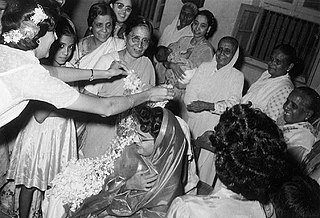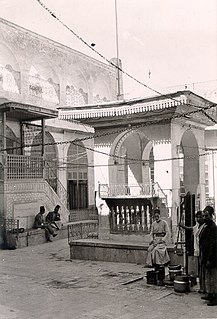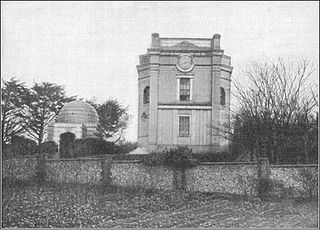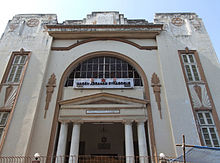
A synagogue is a Jewish or rarely Samaritan house of worship. Synagogues have a place for prayer and may also have rooms for study, a social hall, and offices. Some have a separate room for Torah study, called the בית מדרש beth midrash, lit. "house of study".

The Bene Israel are a community of Jews in India. It has been suggested that it is made up of descendants of one of the disputed Lost Tribes and ancestors who had settled there centuries ago. In the 19th century, after the people were taught about normative Judaism, they tended to migrate from villages in the Konkan area to the nearby cities, primarily Mumbai, but also to Pune, Ahmedabad, India; and Karachi, in today's Pakistan. Many gained prominent positions within the British colonial government and the Indian Army.

Cochin Jews are the oldest group of Jews in India, with roots that are claimed to date back to the time of King Solomon. The Cochin Jews settled in the Kingdom of Cochin in South India, now part of the state of Kerala. As early as the 12th century, mention is made of the Jews in southern India. The Jewish traveler Benjamin of Tudela, speaking of Kollam (Quilon) on the Malabar Coast, writes in his Itinerary:
"...throughout the island, including all the towns thereof, live several thousand Israelites. The inhabitants are all black, and the Jews also. The latter are good and benevolent. They know the law of Moses and the prophets, and to a small extent the Talmud and Halacha."
The history of the Jews in India reaches back to ancient history. Judaism was one of the first foreign religions to arrive in India in recorded history. Indian Jews are a religious minority of India, but, unlike many parts of the world, have historically lived in India without any instances of anti-Semitism from the local majority populace. The better-established ancient communities have assimilated many local traditions through cultural diffusion. While some Jews state their ancestors arrived in India during the time of the Kingdom of Judah, others identify themselves as descendants of Israel's Ten Lost Tribes. It is estimated that India's Jewish population peaked at around 20,000 in the mid-1940s, and began to rapidly decline due to their emigration to Israel after its creation in 1948.

Synagogue architecture often follows styles in vogue at the place and time of construction. There is no set blueprint for synagogues and the architectural shapes and interior designs of synagogues vary greatly. According to tradition, the Divine Presence (Shekhinah) can be found wherever there is a minyan, a quorum, of ten. A synagogue always contains an ark, called aron ha-kodesh by Ashkenazim and hekhal by Sephardim, where the Torah scrolls are kept.

Bevis Marks Synagogue, officially Qahal Kadosh Sha'ar ha-Shamayim, is the oldest synagogue in the United Kingdom in continuous use. It is located off Bevis Marks, Aldgate, in the City of London.

The Chesed-El Synagogue is a synagogue in Singapore. It is located at Oxley Rise in the River Valley Planning Area, within the Central Area of Singapore.

The history of Jews in Pakistan dates at least as far back as 1839. Various estimates suggest that there were about 1,000 Jews to 2,500 living in Karachi at the beginning of the twentieth century, mostly Bene Israel Jews from Maharashtra, India. A substantial community lived in Rawalpindi. A smaller community of Jews also lived in Peshawar. The Bene Israel Jews from Maharashtra were concentrated in Karachi

There are many synagogues in India, although many no longer function as such and today vary in their levels of preservation. These buildings dating from the mid-sixteenth through the mid-20th century once served the country's three distinct Jewish groups—the ancient Cochin Jews, and Bene Israel communities as well as the more recent Baghdadi Jews.

Kemeraltı is a historical market (bazaar) district of İzmir, Turkey. It remains one of the liveliest parts of İzmir.

The New West End Synagogue, located in St. Petersburgh Place, Bayswater, London, is one of the oldest synagogues in the United Kingdom still in use. It is one of two synagogues which have been awarded Grade I listed building status by Historic England, which has described it as "the architectural high-water mark of Anglo-Jewish architecture". It can accommodate approximately 800 people.

The Great Synagogue is a large heritage-listed synagogue located at 187a Elizabeth Street in the Sydney central business district, in the City of Sydney local government area of New South Wales, Australia. Sited opposite Hyde Park, the synagogue extends to Castlereagh Street. It was designed by Thomas Rowe and built from 1874 to 1878, with stonework by Aaron Loveridge. The synagogue was added to the New South Wales State Heritage Register on 10 September 2004. The building is also listed on the Register of the National Estate.

The history of Jews in Burma begins primarily in the mid-19th century, when hundreds of Jews immigrated from Iraq during the British colonial period. Cochin Jews came from India and both groups were part of the development of the British Empire, becoming allied with the British in Burma. At its height in 1940 the community of Jews in the country stood at 2,500 members.

The Central Synagogue of Aleppo,, also known as the Great Synagogue of Aleppo, Joab's Synagogue or Al-Bandara Synagogue, has been a Jewish place of worship since the 5th century C.E. in Aleppo. When it functioned, it was considered the main synagogue of the Syrian Jewish community. The synagogue is noted as being the location where the Aleppo codex was housed for over five hundred years until it was removed during the 1947 Aleppo pogrom, during which the synagogue was burned. This synagogue still stands.

The Montefiore Synagogue is the former private synagogue of Sir Moses Montefiore. It is an 1833, Grade II* listed building in Ramsgate, Kent, England. The synagogue and mausoleum are cared for and maintained by the Montefiore Endowment. The endowment also maintains the nearby Ramsgate Jewish Cemetery.

The Włodawa Synagogue in Włodawa, Poland is an architectural complex consisting of two historic synagogues and a Jewish administrative building, now preserved as a museum. The complex includes the Włodawa Great Synagogue of 1764–74, the late 18th century Small Synagogue, and the 1928 community building. It is "one of the best-preserved" synagogues in Poland.

Magen David, or the Shield of David, Synagogue is located at the junction of Brabourne Road and Canning Street in Kolkata. Magen David is the second operating synagogue in Kolkata, the other is the Beth El Synagogue at Pollock Street.

The Ohel Rachel Synagogue is a Sephardi synagogue in Shanghai, China. Built by Sir Jacob Elias Sassoon in memory of his wife Rachel, it was completed in 1920 and consecrated in 1921. Ohel Rachel is the largest synagogue in the Far East, and one of the only two still standing in Shanghai. Repurposed first under the Japanese occupation during World War II and again following the Communist conquest of Shanghai in 1949, the synagogue has been a protected architectural landmark of the city since 1994. It was reopened for some Jewish holidays from 1999 and briefly held more regular Shabbat services as part of the 2010 Shanghai Expo.

The New Synagogue of Graz, is a Jewish synagogue in the city of Graz, Austria. Within the city, it is located on David-Herzog-Place, on the right bank of the Mur River in the Gries neighborhood of Graz. The synagogue serves the Jews of Graz, Styria, Carinthia, and southern parts of Burgenland.





















